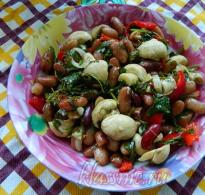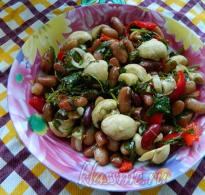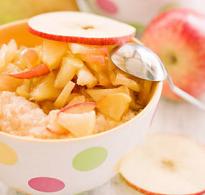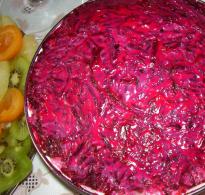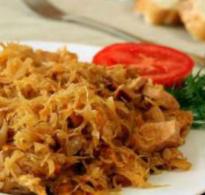In what products is starch found. Starchy and non-starchy vegetables: list and description
Together with food, our body receives all the necessary elements, but often we do not know what the benefits or harms of a particular product are. One of the important organic compounds is starch. It belongs to complex carbohydrates - polysaccharides and is irreplaceable source energy. What is its use and possible harm, as well as which foods contain starch, our article will tell.
Externally synthesized from products, starch is a white powder, tasteless and insoluble in cold water... It is produced by plants during photosynthesis from glucose. Due to complex chemical reactions, some of the glucose is transformed into starch. It accumulates in fruits, grains and tubers, providing reserve nutrition for plants in case of adverse conditions.
Starch is obtained by grinding suitable raw materials and subjecting the resulting mixture to processing chemicals... After cleaning, filtering and drying, the finished starch is ready for use. There are several types of finished starch. The production process has significant differences, as well as the scope of application.
Types of starch:
- Refined starch l is often used in cooking and home recipes. It is obtained from potatoes, corn and some types of grain crops. IN Food Industry its use is extremely demanded, because it is starch that is a kind of stabilizing component in the manufacture of confectionery and sausages, sauces and even baby food.
- Natural starch is contained in almost all herbal products but only in different concentrations... It is an irreplaceable source of energy for our body. For people with active lifestyles, the inclusion of foods with natural starch is a must.
- There is another type of starch that is obtained from modified raw materials... The benefits of such a product are still in doubt, but many manufacturers use it as a cheap ingredient in the food industry.
As raw material for production different types starch are the following crops. In rice grains, the starch content is maximum - about 86%. In wheat, its concentration reaches 75%, in corn - 72%, and in potato tubers up to 28%.
Starchy foods
The main advantage and disadvantage of starch is its rapid absorption by the body. When ingested, foods containing starch are quickly broken down into glucose, raising blood sugar levels. This provokes a feeling of hunger, so it is not recommended to abuse such food. On the other hand, glucose is vital for our body for normal brain function and also helps maintain muscle tone. To independently regulate the amount of starch consumed, you should definitely find out the list of products containing it.
What foods contain the maximum amount of starch:
| Products: | Starch content: |
| Rice flour | 79% |
| Rice groats | 78% |
| Whole grain rice | 75% |
| Barley flour | 72% |
| Wheat flour | 72% |
| Corn flour | 65% |
| Oats | 61% |
| Millet | 60% |
| Chickpea | 50% |
| Barley | 58% |
| Peas | 52% |
| Legumes | 45% |
| Lentils | 40% |
| Beans | 38% |
| Soy | 35% |
| Potatoes | 28% |
Optimal assimilation of these food products occurs with the addition of so-called light fats. These include vegetable oil, sour cream and cream. When combined, certain chemical reactions occur that help saturate the body. the required amount carbohydrates, but no supersaturation.
Table of ready meals containing starch:
| Name: | Starch content: |
| Pasta | 75% |
| Cornflakes | 74% |
| homemade noodles | 65% |
| Butter rusks | 61% |
| Cereal rusks | 58% |
| Tortillas | 52% |
| Kissel | 51% |
| White bread | 48% |
| Rye bread | 45% |
The consumption of such foods helps to saturate the body with carbohydrates, but in large quantities this can negatively affect the functioning of internal systems and lead to obesity. Each serving triggers the release of insulin so that glucose can be absorbed safely. Such a load does not always have positive influence on the body, so you should pay attention to foods containing starch in low concentrations.
List of starch-free foods:
- Eggs.
- Meat.
- Fish, seafood.
- Milk products.
- Cucumbers.
- Onion garlic.
- Tomatoes.
- Cabbage.
- Carrot.
- Beet.
- Bulgarian pepper.
- Eggplant.
- Zucchini.
- Turnip.
- Leafy vegetables and greens.
- Gherkins.
This is an ideal diet for those wishing to lose weight, because the carbohydrate content in such a diet will be minimal. However, do not forget that healthy eating should include as much variety as possible, especially with increased mental or physical stress.
Daily starch intake
Starch intake should be regulated depending on age, gender and degree of physical and mental stress. As mentioned earlier, getting into our body, this compound is very quickly broken down into glucose, which means that the body is saturated. On the other hand, excessive consumption of starch has Negative influence on the body and leads to cardiovascular problems - vascular system, dysfunction of the pancreas and even the development of obesity.
To avoid this, you need to know exactly what amount will be optimal and will only bring benefits.
Daily starch intake is:
- For children, this figure ranges from 50 to 150 grams, depending on the age and weight of the child.
- For adults daily rate is 330 grams.
- During pregnancy and lactation, the load on the body is stronger, which means that the rate can be increased to 350 - 400 grams.
Almost all foods that we consume contain starch in different concentrations, therefore, the daily diet should be as varied and nutritious as possible, but without an overabundance of the same substances. The ideal ratio for this would be 1: 1: 4, which means that for each serving of protein and fat, you need to consume four times more carbohydrates.
Useful starch
The so-called resistant starch... It takes longer to be absorbed and secreted a large number of energy for the body. It has been proven that regular inclusion in the diet of foods containing "useful" starch helps to renew tissues at the cellular level, accelerates metabolism and prevents the development of tumors.
The maximum content of useful starch is found in legumes, especially beans and lentils. Whole grains (buckwheat, oats and rice) are slightly inferior in concentration, but also boast the presence of this beneficial compound. Roots also contain healthy starch... These are potatoes, Jerusalem artichoke, yams and sweet potatoes. It is also found in small amounts in fresh fruit and berries, so you should definitely include them in your daily diet.
An irreplaceable source of energy for our body - starch, is not only beneficial. Excessive consumption leads to the development of severe conditions, in particular, obesity, therefore reasonable limitation starch-rich foods are a must.
Starch, which turns into glucose when digested, is the most common form of polysaccharides in nature, so the separation of vegetables into non-starchy and starchy has become a part of healthy eating diets. Initially, the division of vegetables into non-starchy and starchy was an element of theory. separate power supply... Fitness calculator.
Non-starchy vegetables play a positive role for weight loss, but vice versa.
Most of the starch is found in root crops and large grains, which store nutrients to ensure the growth of the plant's seed. Potatoes have the highest starch content of all vegetables - up to a fifth of the volume of a potato, which is the first reason for excluding potatoes from weight loss diets.
To reduce the negative effect of starchy vegetables on the process of losing weight, it is better to eat starchy vegetables with green non-starchy vegetables, fats (vegetable / animal), it is better not to combine them with proteins, sugar and acids. We recommend that you eat no more than one type of starchy vegetables at a time.
Complete list of starchy vegetables.
- Corn,
- Beet,
- Swede,
- Chestnut,
- Carrot,
- Dry (ripe) beans, other than soybeans,
- Jerusalem artichoke,
- Potatoes (including sweet),
- Radish,
- Dry (ripe) peas,
- Zucchini,
- Patissons,
- Plant roots (parsley, parsnip, celery, horseradish),
- Pumpkin (round, autumn),
- Radish.
Starch-free vegetables.
Everyone's favorite tomatoes that make up a good tomato diet are neither starchy nor non-starchy vegetables. It was found that the main nutritional characteristic tomato is acidic, not the presence of starch. In view of great content acids (citrus, malic and oxalic) in the tomato are referred to sour foods, and they are not recommended to be eaten with starchy vegetables, but allowed with leafy vegetables and fats. Calorie calculator online.
List of moderately starchy vegetables.
It should be taken into account that eggplant in various interpretations is classified as both non-starchy and moderately starchy vegetables.
Complete list of non-starchy vegetables.
- Mustard,
- Green pea,
- Turnip tops and other ground green parts edible plants,
- Beet leaves and leaf beets (chard),
- Eggplant,
- Broccoli,
- Brussels sprouts,
- Chicory,
- Cucumbers,
- Garlic (greens, cloves),
- Spinach,
- Chinese (Beijing) cabbage,
- Cabbage (savoy, kohlrabi, white cabbage, garden cabbage, red cabbage, fodder),
- Watercress and watercress,
- Celery (greens),
- Bell pepper,
- Asparagus,
- Summer pumpkin (yellow oblong),
- Latuk, etc. leaf salad,
- Onions (shallots, onions, chives, leeks, leeks),
- Dandelion greens,
- Okra,
- Okra,
- Parsley (greens) and other table herbs,
- Bamboo shoots,
- Rape (greens),
- Sorrel.
Carbohydrates can be divided into three main categories: sugar, fiber, and starch. Starches are the most commonly consumed type of carbohydrate and an important source of energy for many people. Cereals and root vegetables are common sources of starches.
Starches are classified as because they are made up of many sugar molecules joined together. Complex carbohydrates have traditionally been viewed as healthier options. Getting into digestive system, they gradually release sugar into the blood without dramatically increasing blood sugar levels ().
Blood sugar spikes are bad because they can leave you tired, hungry, and hungry for more foods. high content carbohydrates (,).
However, many starchy foods are highly refined. Consuming them can actually cause your blood sugar to rise rapidly, even though they are classified as complex carbohydrates.
This is due to the fact that highly refined starches are deprived of almost all nutrients and. Simply put, they contain empty calories and provide little or no nutrient intake.
Many studies have also shown that a diet enriched with refined starches is associated with a higher risk of type 2 diabetes, heart failure, and weight gain (,,,).
So, what foods contain starch - the list below.
1. Corn flour (74%)
Corn flour is a type of flour coarse obtained by grinding dried corn kernels. It does not contain, which makes it possible to safely use it for people with.
Although cornmeal contains some nutrients, it is very rich in carbohydrates and starch. 100 g of corn flour contains 79 g of carbohydrates, of which 74 g (74%) is starch ().
Summary:
Unfortunately, pretzels are often made from refined wheat flour. This type of flour can cause spikes in blood sugar levels, which can lead to feeling tired and ().
More importantly, frequent spikes in blood sugar levels can reduce your body's ability to effectively lower blood sugar levels and even lead to type 2 diabetes (,,).
Summary:
Pretzels are often made from refined wheat flour and can quickly raise blood sugar levels. A 60 gram serving of 10 rolled pretzels contains 42.8 grams (71.4%) starch.
3-5: Flour (68-70%)
Flour is a versatile and basic baking ingredient that can be different varieties e.g. sorghum, millet, wheat and refined Wheat flour... All of these flours also tend to contain starch. So, which foods contain starch:
3. Millet flour (70%)
Although millet contains tons of nutrients, there is some evidence that its consumption can interfere with normal functioning. thyroid gland... However, the effects in humans are unclear, so more research is needed (,,).
4. Sorghum flour (68%)
Sorghum is an ancient nutritious grain (groats) that is ground into sorghum flour. 100 g of sorghum flour contains 68 g of starch (68%). Despite its high concentration, sorghum flour is much the best choice than most types of flour. This is because it is gluten free and an excellent source of protein and fiber. 100 g of sorghum flour contains 8 g of protein and 6.3 g of fiber ().
Plus, sorghum is an excellent source of antioxidants like policosanol. Research has shown that these antioxidants can help reduce insulin resistance and may have anti-tumor properties (,,).
Find out in detail what sorghum is and what benefits it can bring.
5. White flour (68%)
Whole wheat grains have three key constituents. The outer layer is known as, the embryo is the reproductive part of the grain, and the endosperm is its nutrition.
White flour is made by removing the bran and germs that are ().
Only the endosperm is left, which is ground into white flour. It tends to be low in nutrients and contains mostly empty calories ().
In addition, due to the fact that white flour is based on endosperm, it contains a large amount of starch. 100 g of white flour contains 68 g of starch (68%) ().
Summary:
Millet flour, sorghum flour and white wheat flour are popular species flour with a similar starch content. Of the three, sorghum flour is the healthiest, while wheat flour white flour is the most harmful and should be avoided.
6. Salty crackers (67.8%)
What foods have a lot of starch - one of these foods is salt crackers. Salty crackers are thin, square dry biscuits made from refined wheat flour, yeast, etc. Although salty crackers are low in calories, they contain virtually no vitamins and minerals. In addition, they contain a very large amount of starch.
For example, a serving of five standard salted crackers (15 g) contains 11 g (67.8%) starch ().
If you like crackers, go for those that are 100% made.
Summary:
Although salty crackers are popular snacks, they are low in nutrients and high in starch. A serving of five standard salted crackers (15 g) contains 11 g of starch (67.8%).
7. Oats (57.9%)
Oats are the most useful cereal that you can eat. Oats provide the body with good amounts of protein, fiber and fat, and a wide range vitamins and minerals. This makes oats a great choice for a healthy breakfast.
What's more, research has shown that oats can help you lose weight, lower blood sugar, and lower your risk of developing cardiovascular disease ( , , ).
However, despite the fact that oats are one of the healthiest foods and a great addition to your diet, it also contains a lot of starch. 100 g of oats contains 57.9 g of starch (57.9%) ().
Summary:
Oats - great choice for breakfast, as it contains a large amount of vitamins and minerals. 100 g of oats contains 57.9 g of starch (57.9%).
8. Whole wheat flour (57.8%)
Compared to refined flour, whole wheat flour is more nutritious and contains less starch. It makes her the best option... For example, 1 cup (120 g) whole grain flour contains 69 g of starch or (57.8%) ().
Although both types of wheat flour contain the same amount of carbohydrates, whole wheat has more fiber and nutrients. This makes it a healthier option.
Summary:
Whole wheat flour is a great source of fiber and nutrients. One glass (120 g) contains 69 g of starch (57.8%).
9. Instant noodles (56%)
Noodles fast food- popular and convenient product because it is cheap and easy to prepare. However, these noodles are highly processed and generally low in nutrients. In addition, it tends to be high in fat and carbohydrates.
For example, one packet contains 54 g of carbohydrates and 13.4 g of fat ().
Most of the carbohydrates from instant noodles come from starch. The package contains 47.7 g of starch (56%). In addition, studies have shown that people who consume instant noodles more than twice a week have a higher risk of metabolic syndrome, diabetes, and cardiovascular disease. It is especially harmful for women (,).
Summary:
Instant noodles are highly processed and rich in starch. One packet contains 47.7 g of starch (56%).
10-13: Bread and bakery products (40.2-44.4%)
Bread and various types of baked goods are staple foods all over the world. These include White bread, bagels, pancake (thick wheat flour flatbread), tortilla, lavash, etc.
However, many of these foods are made from refined wheat flour and have a high glycemic index. This means they can quickly raise blood sugar levels. The starch content of such flour products typically ranges from 40.2 to 44.4 percent.
10. Fritters (44.4%)
Fritters are flat round bread which is usually fried and served with butter. A regular size pancake contains 23.1 g of starch (44.4%) ().
11. Bagels, bagels, bagels (43.6%)
Bagels, bagels, bagels, and other baked goods of this type are common products made from white flour. They contain a large amount of starch, providing the body with 38.8 g, when consumed in a medium-sized bagel (43.6%) ().
12. White bread (40.8%)
Like refined wheat flour, white bread is made almost exclusively from wheat endosperm. In turn, it has a high starch content. Two slices of white bread contain 20.4 g of starch (40.8%) ().
White bread is also very low in fiber, vitamins and minerals. If you want to eat bread, go for whole grain bread.
13. Tortilla (40.2%)
Tortilla is a thin, flat bread made from corn or wheat (traditional mexican tortilla). One lozenge (49 g) contains 19.7 g of starch (40.2%) ().
Summary:
Bakery products are different forms, but usually contain starch, and therefore their consumption should be limited. Baked goods such as pancakes, bagels, bagels, bagels, white bread, and tortillas contain about 40-45% starch.
14. Shortbread (40.5%)
Classic shortbread cookies are traditionally made with three ingredients - sugar, butter and flour. It is also high in starch content. One 12-gram cookie contains 4.8 g of starch (40.5%) ().
Also, be careful when consuming factory-made shortbread cookies as it may contain artificial trans fats, which are associated with a higher risk of cardiovascular disease, diabetes and obesity (,).
Summary:
Shortbread cookies contain a large amount of starch - 4.8 g per cookie (40.5%). It is recommended that you limit your intake as it is high in calories and may contain trans fats.
15.Rice (28.7%)
Starchy foods include rice, which is the most commonly consumed food. base product supply in many countries of the world ().
It contains a large amount of starch, especially when raw. For example, 100 grams of raw rice contains 80.4 g of carbohydrates, of which 63.6% are starch ().
However, during the cooking of rice, the content of this polymer carbohydrate decreases dramatically. In the presence of heat and water, the starch molecules absorb water and swell. Ultimately, this swelling breaks down the bonds between starch molecules in a process called gelation ().
Thus, 100 g of cooked rice contains only 28.7% starch, because cooked rice contains much more water ().
Summary:
Rice is the most commonly consumed staple food in the world. When cooked, the starch content in it decreases sharply, because its molecules absorb water and are destroyed during the cooking process.
16. Pasta from durum wheat (26%)
Pasta from hard varieties Wheat comes in many forms, such as spaghetti, pasta, noodles, fettuccine, etc. As with rice, pasta boils less starch because it gelatinizes when heated in water. For example, dry spaghetti contains 62.5% starch, while cooked spaghetti contains only 26% of this polymer carbohydrate (,).
17. Corn (18.2%)
Starchy foods include corn. Corn is one of the most widely consumed cereals. It also has the highest starch content of a whole vegetable ().
For example, 1 cup (141 g) corn kernels contains 25.7 g (18.2%) starch. Although it is a starchy vegetable, corn is very nutritious and a great addition to your diet. It is especially rich in fiber, as well as vitamins and minerals such as folate (vitamin B9), phosphorus and potassium ().
Summary:
Although corn contains a lot of starch, it is very healthy due to its fiber, vitamins and minerals. One cup (141 g) corn kernels contains 25.7 g (18.2%) starch.
18. Potatoes (18%)
Potatoes are incredibly versatile and are a staple food in many families around the world. When it comes to starchy foods, potatoes are often the first thing that pops up in your mind. Interestingly, potatoes do not contain as much starch as flour, baked goods, or cereals, but they do contain more of this carbohydrate than other vegetables.
For example, a medium baked potato (138 g) contains 24.8 g of starch (18%).
Potatoes are a great part of a balanced diet because they are good source vitamin C, folic acid, potassium and manganese ().
Summary:
Although potatoes are rich in starch compared to most vegetables, they also contain many vitamins and minerals. This is why potatoes are still a great part of a balanced diet.
Summarize
- What foods have the most starch - the largest amount is found in corn flour(as much as 74%).
- Starch is the main carbohydrate in the diet and a significant part of many staple foods.
- In modern human diets, foods high in starch are highly refined and devoid of fiber and nutrients. These products include refined wheat flour, baked goods and baked goods, and corn flour.
- To maintain a healthy diet, try to limit your intake of these foods. Diets high in refined starches are associated with a higher risk of diabetes, heart disease, and weight gain. In addition, they can cause blood sugar levels to rise sharply and then drop sharply. This is especially important for people with diabetes mellitus and prediabetes because their bodies cannot effectively remove sugar from the blood.
On the other hand, you should not avoid consuming whole, unprocessed starch sources such as sorghum flour, oats, potatoes, and the other high-starch foods listed above. They are excellent sources of fiber and contain many vitamins and minerals.
What foods contain the most zinc
Discussion: there is 1 comment
Starch is a substance that, when heated to 55-65 ° C, turns into gluten, which is very harmful to the body. Especially for the liver…. In this case better products such cook at temperatures below 55 ° C and it is better to soak porridge overnight in clean water.
Reply
Starch, which is converted to glucose during digestion, is one of the most abundant forms of polysaccharides in nature. Therefore, the division of vegetables into starchy and non-starchy, which was originally part of the theory, found a place in the universal. Non-starchy vegetables are real helpers in losing weight, but with starchy vegetables you should keep your ears open! But how not to confuse? Our help service with convenient tables will help.
Vegetable menu is not synonymous with weight loss menu! Vegetables are different, and, accordingly, the rules for their combination with each other and with other products differ.
The largest percentage of starch content is characteristic of root crops and large grains, which accumulate nutrients to continue growth and provide a "food supply" to the plant embryo. The most "pronounced starchy" vegetable is undoubtedly potatoes- starch can represent up to 1/5 of the tuber volume! That is why those who want to lose weight, first of all, give up potatoes.
Starchy vegetables: a complete list
| Swede |
| Corn |
| Carrot |
| Beet |
| Ripe (dry) beans, excluding soybeans |
| Ripe (dry) peas |
| Zucchini |
| Squash |
| Potatoes (all types and varieties, including sweet) |
| Chestnuts |
| Edible plant roots (horseradish, parsley, parsnip, celery) |
| Pumpkin (round, autumn ripening) |
| Jerusalem artichoke |
| Radish |
| Radish |
Moderately starchy vegetables: two list options
Non-starchy vegetables: a complete list
| Eggplant |
| Broccoli |
| Brussels sprouts |
| Mustard |
| Green pea |
| Chinese cabbage |
| Kohlrabi |
| Cabbage (white cabbage, red cabbage, savoy cabbage, garden cabbage, fodder) |
| Watercress and watercress |
| Asparagus |
| Summer gourd (oblong yellow) |
| Lettuce and other types of lettuce |
| Turnip greens and other terrestrial green parts of edible plants |
| Beet Leaves and Beetroot (Swiss Chard) |
| Onions (onions, shallots, leeks, chives, leeks) |
| Cucumber |
| Dandelion greens |
| Okra |
| Okra |
| Parsley (herbs) and other table herbs |
| Bamboo shoots |
| Rape (greens) |
| Celery (greens) |
| Bell pepper |
| Chicory |
| Garlic (herbs and cloves) |
| Spinach |
| Sorrel |
Starch-free vegetables
| A tomato | cm. |
It is a white, tasteless powder that is familiar to many of us. It is found in wheat and rice grains, beans, potato tuber, and the cob of corn. However, in addition to these products, we find starch in boiled sausage, ketchup and, of course, in all kinds of jelly. Depending on their origin, starch grains vary in shape and particle size. When the starch powder is squeezed in the hand, it emits a characteristic squeak.
Starch-rich foods:
Indicated approximate quantity in 100 g of product
General characteristics of starch
Starch is absolutely insoluble in cold water. However, under the influence hot water it swells and turns into a paste. While studying at school, we were taught that if you drop a drop of iodine on a piece of bread, the bread will turn blue. This is due to the specific reaction of starch. In the presence of iodine, it forms the so-called blue amyl iodine.
By the way, the first part of the word - "amil", indicates that starch is a slimy compound and consists of amylose and amylopectin. As for the formation of starch, it owes its origin to the chloroplasts of cereals, to potatoes, as well as to a plant that is called maize in its homeland, in Mexico, and we all know it as corn.
It should be noted that, in terms of its chemical structure, starch is a polysaccharide, which, under the influence of gastric juice, is capable of being converted into glucose.
Daily starch requirement
As mentioned above, under the influence of acid, starch is hydrolyzed and converted into glucose, which is the main source of energy for our body. Therefore, in order to feel good, a person must definitely eat some starch.
You just need to eat cereals, bakery and pasta, legumes (peas, beans, lentils), potatoes and corn. It is also good to add at least a small amount of bran to your food! For medical reasons, daily requirement organism in starch is 330-450 grams.
The need for starch increases:
Since starch is a complex carbohydrate, its use is justified if a person has to work for a long time, during which there is no possibility of frequent meals. Starch, gradually transforming under the influence of gastric juice, releases glucose necessary for full life.
The need for starch is reduced:
- at various diseases liver associated with impaired breakdown and assimilation of carbohydrates;
- with low physical exertion. In this case, starch is able to be converted into fat, which is deposited "pro-storage";
- in the case of work requiring an immediate supply of energy. Starch, on the other hand, is converted into glucose only after some time.
Starch digestibility
Due to the fact that starch is a complex polysaccharide, which, under the influence of acids, is fully converted into glucose, the assimilability of starch is equal to the assimilation of glucose.
Useful properties of starch and its effect on the body
Since starch is able to convert into glucose, its effect on the body is similar to glucose. Due to the fact that it is absorbed more slowly, the feeling of satiety from use starchy foods higher than with the direct use of sweet foods. At the same time, the load on the pancreas is much less, which has a beneficial effect on the health of the body.
Interaction of starch with other essential elements
Starch interacts well with substances such as warm water and gastric juice. In this case, water makes the starch grains swell, and hydrochloric acid, which is part of the gastric juice, turns it into sweet glucose.
Signs of a lack of starch in the body
- weakness;
- fast fatiguability;
- frequent depression;
- decreased immunity;
- decreased sex drive.
Signs of excess starch in the body:
- frequent headaches;
- overweight;
- decreased immunity;
- irritability;
- small bowel problems;
Starch and health
Like eating any other carbohydrate, starch should be strictly regulated. Do not consume excessive amounts of starchy substances, as this can lead to the formation of fecal stones. However, you should not avoid the use of starch either, because in addition to a source of energy, it forms a protective film between the wall of the stomach and gastric juice.

